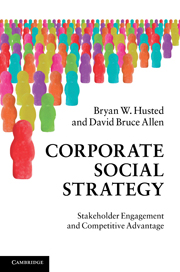Book contents
- Frontmatter
- Contents
- Figures
- Tables
- Acknowledgments
- 1 Introduction
- Part I Fundamentals
- Part II The process of developing corporate social strategy
- 6 Competitive environment
- 7 From stakeholder management to social strategy
- 8 Resources and capabilities
- 9 Organizational identity
- Part III Implementing social strategy
- Bibliography
- Index
6 - Competitive environment
Published online by Cambridge University Press: 05 June 2012
- Frontmatter
- Contents
- Figures
- Tables
- Acknowledgments
- 1 Introduction
- Part I Fundamentals
- Part II The process of developing corporate social strategy
- 6 Competitive environment
- 7 From stakeholder management to social strategy
- 8 Resources and capabilities
- 9 Organizational identity
- Part III Implementing social strategy
- Bibliography
- Index
Summary
Introduction
Following the presentation of our model for developing social strategy, we now turn to considering the competitive conditions conducive to corporate social strategy having a positive impact on firm performance. As should be clear from our presentation of the model, social strategy is not amenable to a one-size-fits-all approach. Rather, the formulation of social strategy must take into account both the competitive context and the unique resources and capabilities that a firm brings to the task. Scholars have argued that the development of market-based advantages is useful in less dynamic environments, while the development of capability-based advantages is vital to moderately dynamic and high-velocity environments (Grant, 1996; Teece et al., 1997; Eisenhardt and Martin, 2000). In this chapter we will focus on how firms can achieve an advantageous market position through social strategy in different environments; in Chapter 8, we will take a closer look at resources and capabilities.
The task of characterizing the competitive environment is especially challenging due to the varying ways scholars have taken up the issue (Boyd et al., 1993). Two approaches stand out. The first is based on industrial organization economics and uses the tools of game theory to model social investment under different competitive assumptions. This approach is often applied to the macro-environment and the study, via mathematical measures, of strategic decision-making and firm behavior under norms of rationality. The second approach (introduced in Chapter 4 in our analysis of the market environment – Step 1 of Corporate Social Strategy), develops qualitative evaluations of the competitive context at multiple levels, both for the industry, and for the individual firm. This methodology depends on perceptual measures that describe the corporate decision-makers’ evaluations of the competitive environment.
- Type
- Chapter
- Information
- Corporate Social StrategyStakeholder Engagement and Competitive Advantage, pp. 107 - 127Publisher: Cambridge University PressPrint publication year: 2010
- 4
- Cited by



